* this story tells of our first Lotus Birth, and how to do your own. I will write about our second Lotus Birth and put it on the blog another time. Enjoy *
Lotus Birth is the practice of leaving the baby’s cord uncut after birth, so that baby and placenta remain attached until the cord naturally separates, just as a cut cord does, at 2 to 10 days after birth. Lotus birth is new in our culture, but reflects the respect that many traditional cultures have for the placenta – the baby’s first companion. This process allows a most gentle transition for a newborn baby, extending the sacredness of the time between womb and world. Energetically, the placenta and baby are linked as one, and if this connection is honoured, the baby will release the cord when they’re ready, just as they would release the cord stump. The placenta and cord are washed, dried and then preserved with dried ground rosemary which is an antibacterial, anti-fungal and a drying agent and smells very pleasant. Did you know that leaving the cord uncut, at least until it stops pulsating, gives your baby an extra 30-50% blood that has been stored in the placenta? Or that objects such as bags, pull-along toys, and even pets may symbolically represent our lost placenta? Physically, the job of the placenta is finished within a few hours of birth, but on an energy level the benefits of remaining connected to the placenta continue until the baby is ready to let it go. It’s a way to honour this connection for a few more days, rather than severing it immediately after birth.
Why do a Lotus Birth?
According to ‘Sacred Birthing’ by Sunni Karl, the baby and placenta actually live within the same auric field, in an “egg of light, still protected as if by an energetic womb.” When the cord is cut at birth and the placenta is removed, half of the aura is suddenly gone. This looks like a torn bubble whose edges are flapping openly around the baby, offering no protection. To repair the aura uses a great deal of baby’s vitality to complete, even in a healthy, hearty babe. If this is a baby whose health has already been compromised by interventions in pregnancy, a traumatic birth, or whose health has been neglected by lifestyle practices of mother or father, the extra energy needed to repair this tear is not readily available and takes much longer. This comes at a crucial time in development when baby is adjusting to this world, leaving baby open to immediate health difficulties like digestive problems, colic, colds, tummy aches and gas. Protecting the umbilical cord upholds the energy field and protects baby’s immune system. Keeping the cord intact keeps baby’s aura intact. Birth can happen the way nature intended, without any hovering scissors.
A benefit I received, as a mother, from doing a Lotus Birth was the sense of peace and tranquility in being able to immerse myself in the stillness and radiance of my newborn without picking up and carrying on life as usual straight away. Even the few visitors we had during this time were aware of the connection our baby had with her placenta. It seemed like she and her placenta were one entity, and we were giving them the time and space to gently release from each other. It was as if the energy of the whole house was raised to a higher vibration, and for those sensitive to it this was truly a magical experience. Also, for those first few days, our baby watched us through peaceful eyes as she basked in her radiance, totally at ease with herself and the world around her. Totally safe and tranquil, totally connected.
During a deep meditation to heal my own birth trauma, I was confronted with a deep memory of my own cord being cut in the hospital immediately after my birth. As soon as my cord was cut, my body felt cold and afraid, like I had been disconnected from the very source of my life. I gasped and felt like I was falling, alone in the world. Other people have had similar memories arise during healing sessions, and this is another powerful factor which has influenced a growing number of people to consider offering a gentle Lotus Birth to their own babies.
Is Lotus Birth for your baby?
Lotus birth softens the birth experience. Like a water birth, there seem to be only positive effects of Lotus Birth on a baby and its family. They are all unseen and can only be felt. If you are open to this possibility, how does it feel to consider this for your baby? Understanding its benefits, if you would like your baby to experience these gifts, then the logistics will fall easily into place. If you can, decide before labour if this is a path you wish to take. If you are committed, and prepared beforehand, then instead of looking at the placenta as an inconvenience, it is looked at with gratitude for the energetic gifts it is giving to your baby.
How to do a Lotus Birth
What you will need:
- About 3-4 cups of finely ground dried rosemary
- A bucket of warm water and a strainer
- A bamboo steamer (or similar ventilated container)
- Some towels or cloth nappies to absorb moisture
- A willingness and commitment to offer this gift to your baby
On a practical level, once the baby and placenta are born, it is helpful to have a bucket of warm water and a strainer handy to clean the placenta preferably within an hour or so of birth. It is important to be gentle and careful while doing this, as the baby is very sensitive to whatever happens with the placenta. Once the placenta has been thoroughly rinsed, it can be placed in a strainer to drain over a bucket or bowl. Initially it is easy to maneouvre the placenta around for washing, since the cord is still very soft. It is recommended to do as thorough a job as possible when initially cleaning your placenta, as this will make the whole process much easier and avoid smells in the long run. The placenta can be left to drain for a few hours in the strainer.
Now it is time to set yourself up in a comfortable place where you will be cosy for the next few days. Just remember, wherever your baby goes, so does the placenta, so one of the gifts of doing a Lotus birth is to learn to be still and peaceful with your baby. For us, the most practical and comfortable place to set ourselves up after the birth was our bedroom. It is handy to have some towels to place on the bed, so that the placenta can be placed closeby to your baby. The placenta can be initially left to drain for a few hours, which might include time for your baby to have a nap. A few hours later, the placenta can be rinsed again in a fresh bucket of warm water to remove any remaining residue, then pat gently dry with a towel. Once it has been dried carefully, it is time to cover it with dried rosemary. Salt is undesirable to use on the placenta as it interferes with the energetic transference and also absorbs the humidity in the air, making the placenta rot instead of dry in all but the driest climates. Remember that thorough care in the beginning will avoid smells further on, so it is worth being a bit pedantic about covering every nook and cranny of the placenta with rosemary. The cord will be drying out by now and becoming a bit harder, but you can also dust the cord with rosemary. It is also important to sprinkle rosemary liberally around the navel end of the base of the cord to assist in it drying out. Once the placenta is covered with rosemary, it can be placed next to your baby in a suitable container. We found the perfect container was a bamboo steamer (from Asian Grocery store) with a folded toweling nappy in the base of it to absorb any moisture. Over the first 24 hours, it is worth re-sprinkling rosemary and turning the placenta over every few hours, replacing the towel underneath with a fresh one. If it can get plenty of air, that will aid in the dehydration. The placenta will dehydrate and shrink rather quickly over the first day if it is allowed to air, and the cord will become very hard and twisted, like a piece of jerky. It is important to take care when moving your baby, so as not to pull at their belly with the cord.
Here is a picture of our 3 year old daughter Luna, their dad and our midwife sprinkling rosemary on the placenta for the first time.
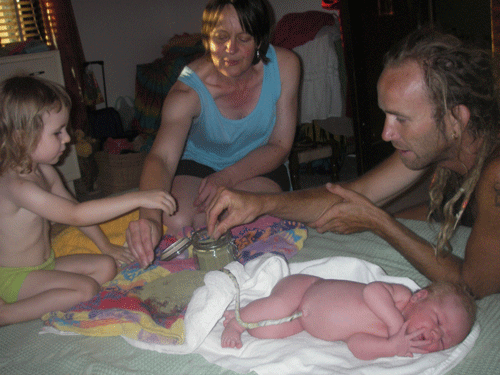
After the initial drying period, the placenta takes much less maintenance. About 2-3 times a day we would turn the placenta over and re-sprinkle rosemary. Some babies let go of their cords in a couple of days, while some keep the connection for a bit longer. After a couple of days we noticed a pleasant, earthy smell mingled with the rosemary. On the third day I began to notice a slight ammonia smell from the placenta, but the main overriding scent was the rosemary. It was dried out enough that we removed the towelling nappy from underneath it so that the air could fully circulate to aid in the dehydration. It is important to continue sprinkling rosemary on and around the navel end of the cord stump to help it dry out, as this will partly determine how long the cord will remain attached for. We were fortunate to have gorgeous warm weather, so there was no need to dress Lotus. It was much easier to keep movements to a minimum so as not to worry about pulling on the cord. It was so precious to see her perfect little naked body lying peacefully on the bed, gently drifting between the worlds of womb and earth.
Here is a picture of Lotus lying peacefully connected with her placenta attached:
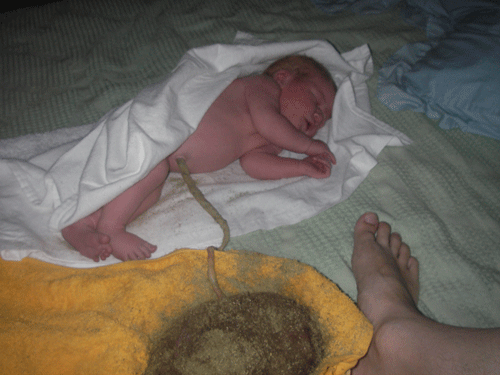
We didn’t move her out of the bedroom at all during this time. I felt totally relaxed about the whole process, and could lie close with her on the bed enjoying the serenity. The day before our baby let go of her cord I could tell she was moving into a new level of awareness. Her eyes were becoming more focused, her breastfeeding was more eager. She was beginning to settle into this world. It really broke everything down into baby steps and gave her and us the space to fully immerse in each new experience, rather than being bombarded with everything all at once. Although I admit there were rare moments of impatience at wanting to whisk her up in my arms and carry her around, I decided to relax and just accept the process no matter how long it would take. I knew it wouldn’t be long, but at the same time I had actually grown quite attached to the whole package myself and in a way was reluctant to see it go. It had served her so well. But I knew it was nearly time. Our baby held onto her cord and placenta for 6 days, which is a relatively long time. Most babies kick theirs off after around 3 or 4 days.
Here is a photo taken immediately after Lotus kicked off her cord:
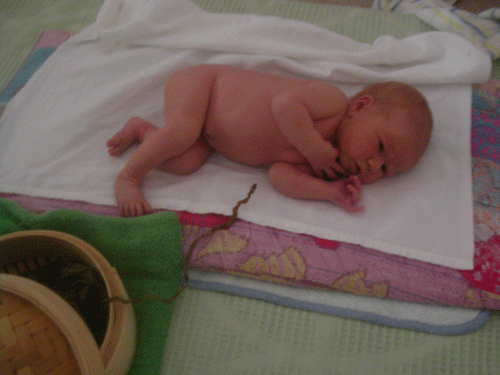
It was such a serene and enriching experience to do the lotus birth, and I would certainly do it again if ever the opportunity arose. Our baby is such a radiant and centred soul, such a content and peaceful baby. Of course there are many contributing factors to this, but I have no doubt that allowing her this sacred experience has helped her transition into this world be as gentle and nurturing as possible. Not only for her, but for our whole family and all those who visited and experienced the powerful connection. And for me it was a huge shift to be still and fully immerse myself in the whole experience, and fully enjoy every moment of that first week of her life. Doing the lotus birth has given our family and our home a new level of peace and tranquillity not previously experienced, and I fully recommend this gift be offered to more babies as our awareness of its benefits expands.
© Alice Fisher 2007
Feel free to share this information with others and spread awareness of Lotus Birth so other babies and families get to experience its gifts, but for permission to reprint contact Alice at alice@bongobaby.com.au or call 0422 379 722.
Recommended further reading:
‘Sacred Birthing’ by Sunni Karl
‘Lotus Birth’ by Shivam Rachana
Here is Lotus and her big sister Luna, 3 years later!
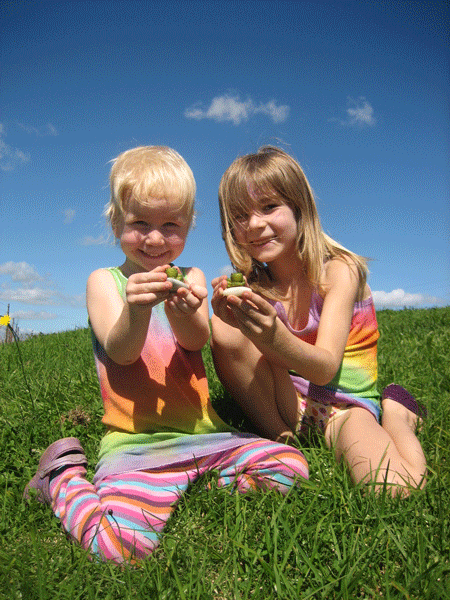
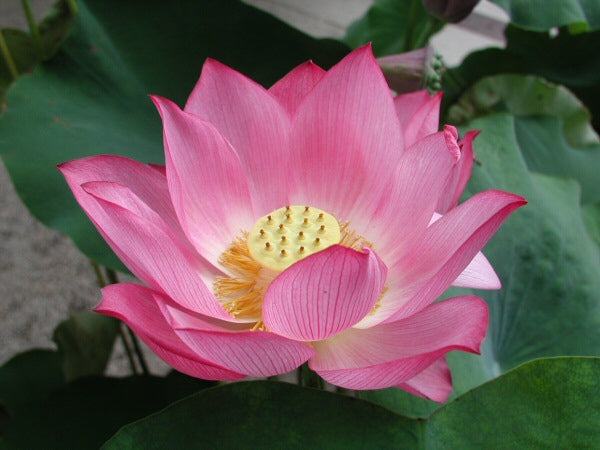
Thank you so much for sharing this. There isn't much information -beyond the basics- on lotus birth so it was refreshing and very informative to read your post. I found it particularly helpful to read about the benefits that lotus birth provided your bub and your family and your tips on taking care of the placenta.
ReplyDeleteI am committed to giving our bub a lotus birth but have had some reservations, mainly the potential smell and my possible impatience. Your post has made me feel very calm and much more prepared. Looking at the pics of your little one with her cord, and placenta attached, gave me an overwhelming sense that lotus birth is the 'right' path for us.
Thank you.
Hi LilyFrog,
ReplyDeleteI'm so happy that this post was helpful for you and you feel inspired to do a Lotus Birth. I would love to hear how your journey was.
Bongo Mama xx